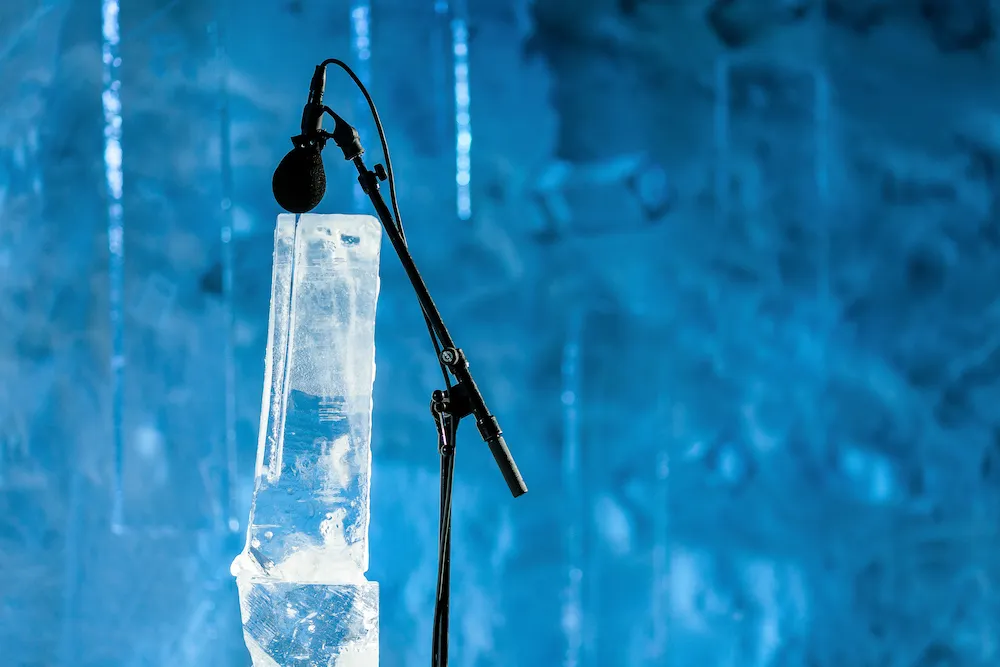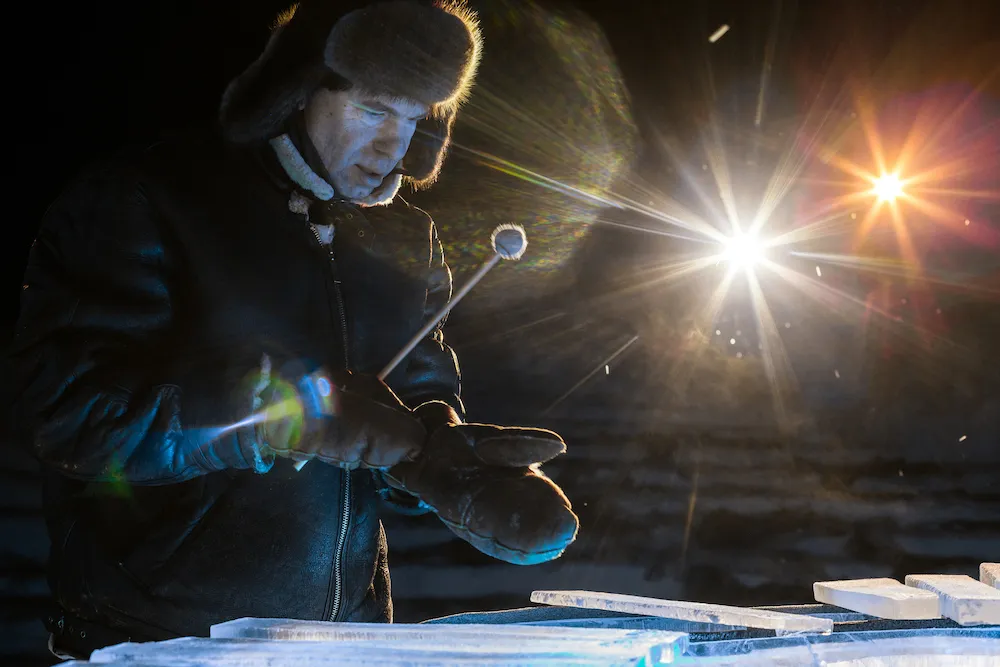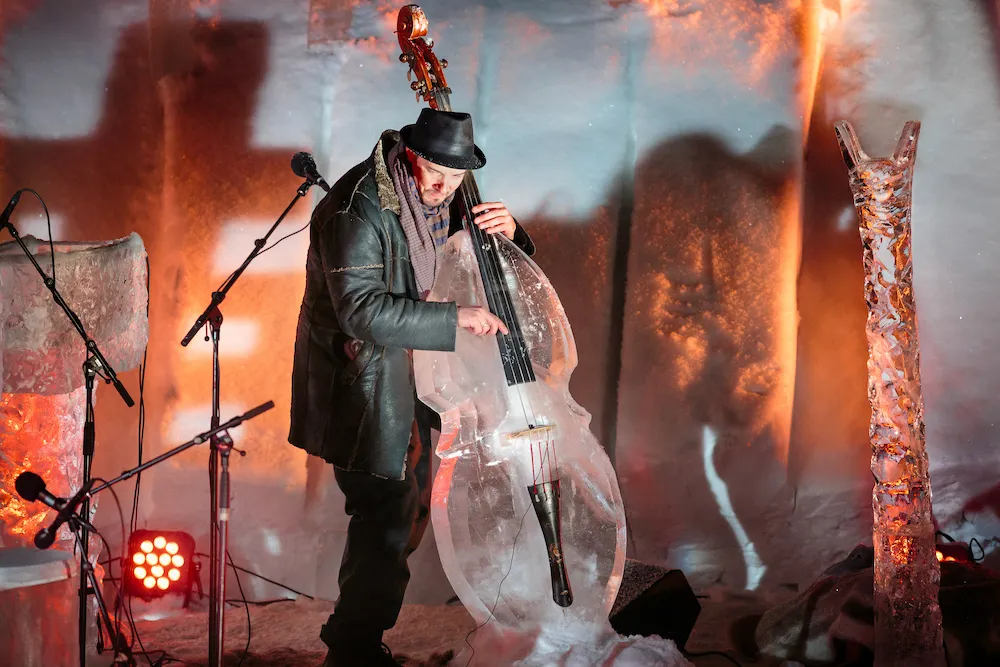These Musical Instruments Are All Made of Ice
Chill out at Norway’s Ice Music Festival this February
:focal(338x119:339x120)/https://tf-cmsv2-smithsonianmag-media.s3.amazonaws.com/filer/3e/98/3e982b11-65e5-43d3-8bb2-3894d9f47c71/smithsonian_magazine_ice_music_festival_emile_holba-4.jpg)
While most musicians rely on roadies to tune their instruments, musicians at the Ice Music Festival work with a team of ice carvers to prep their gear. Located in Finse, Norway, the annual event is the only one in the world dedicated to the art of making music using instruments constructed out of ice.
But not just any ice will do. For this year’s festival, ice carvers have selected the frozen waters of Lake Finse, located just south of the village, as well as a nearby glacier, as their materials of choice. Armed with chainsaws, chisels and hammers, they’re tasked with the finger-numbing process of fashioning blocks of ice into guitars, woodwinds, keyboard and drums—even the stage is carved out of ice.
To ensure that there is enough ice to work with, the festival has been moved to Finse, located about 30 miles from Geilo, where the event debuted in 2005. Over the years the temperature in Geilo has become abnormally warm, making it a challenge for the stage and instruments to stay frozen.
“In the last three or four years, temperatures have been all over the place, but we noticed a huge shift last winter,” Emile Holba, co-producer of the Ice Music Festival, tells Smithsonian.com. “Normally during this time of year it should be consistently 15 to 20 degrees Celsius below zero, and there should still be snow on the ground through May. Last year the preparation was difficult, and we had to make snow in order to create the stage and amphitheater.”
Fortunately, festival founder Terje Isungset feels optimistic that this year’s location change will make for a better and more intimate festival. It will also allow for the construction of an igloo.
“We’re in a much more secure spot to keep things frozen where we are this year." Isungset tells Smithsonian.com. "We can really experiment with the ice.”
Isungset, a seasoned jazz percussionist, originally came up with the idea to use ice as an instrument in 1999 when he performed inside a frozen waterfall in Lillehammer. He would become the first person ever to create an ice music recording, using elements like the actual waterfall combined with stones and wood to make sounds.
“It sounded fantastic, so I wanted to continue the work,” he says. “It took a lot of trial of error. I’m a drummer so the first thing I made was percussion, and then an ice trumpet and an ice harp. Every year we try to create a new instrument. Last year we made a variation of a saxophone that was curved like a traditional sax but with two openings for the sound to come out rather than just one. Our goal with the festival is to challenge musicians to try new instruments that might not sound exactly like what they’re used to.”
Insungset attests that the instruments sound similar to their traditional cousins, but with a softer sound. One musician who was up for the challenge was Anders Jormin, a Swedish jazz bassist and composer. Working side by side with an ice artist, the duo created the world’s first ice double bass.
“The challenge was making the long neck, which is normally quite thin, but the strings create a lot of pressure and we found out quickly that their tension caused the neck to break,” Jormin tells Smithsonian.com. “We wound up using a wooden neck and gut strings. The resonating space for the instrument was also smaller than that of a normal bass. This made the final instrument sound softer than one made of wood, but it still works.”
Jormin says he stored the bass in a freezer and plans to use it again this year, but with slight modifications.
“Playing an ice instrument is out of my comfort zone and challenges my improvising skills,” he says. “Two hours before a performance is when I decide what my set will be like. You can’t make sensitive music while wearing gloves, [so] since it’s extremely cold outside, the musicians take turns performing so they can warm up [their fingers]. The delicate sound of ice instruments adapts to how much you can play before no longer feeling your hands.”
In years past, artisans experimented with manmade ice to help expedite the instrument-making process, which begins weeks before the first musician steps on stage, but noticed that the sound of the resulting instruments just didn't compare to what resonates from instruments crafted out of naturally frozen ice.
“If you take artificially frozen ice out of the freezer, acoustically it has no sound properties. It’s as flat as concrete; it has nothing,” Holba says. "[Ice from the lake, on the other hand], has a hugely dynamic acoustic composition. You can tune it to a D flat, and it sounds correct. The musicians are always shocked at how accurate the sound is."
Erland M. Schulson, founder and director of the Ice Research Laboratory and a professor of engineering at the Thayer School of Engineering at Dartmouth College, speculates on why this might be the case. "I don't know exactly why natural ice makes a bright sound, but I'd bet it has something to do with porosity, meaning entrapped air bubbles," he tells Smithsonian.com. "Unless care is taken, man-made ice can be quite porous, so more bubbly than ice grown slowly from freshwater, like that found in lakes or rivers, under natural conditions. Bubbles, when entrapped within ice, lower its stiffness – its elastic modulus, which, in turn, lowers the velocity of sound... [These] bubbles, I imagine, 'deaden' sound by smearing out frequencies, owning to scattering from the air-ice interfaces."
"That's just a guess," he added. "In my lab at Dartmouth, we can grow ice that's almost bubble-free. We've never made a musical instrument from the stuff, but it would be fun to try."
Until Dr. Schulson pulls a band together, Finse is the place to be for those looking for an icy acoustic experience. This year’s Ice Music Festival will be held February 2 and 3.

/https://tf-cmsv2-smithsonianmag-media.s3.amazonaws.com/filer/b5/fd/b5fd9446-c34e-4280-a3e7-742d27234660/smithsonian_magazine_ice_music_festival_emile_holba-3.jpg)
/https://tf-cmsv2-smithsonianmag-media.s3.amazonaws.com/filer/3e/98/3e982b11-65e5-43d3-8bb2-3894d9f47c71/smithsonian_magazine_ice_music_festival_emile_holba-4.jpg)
/https://tf-cmsv2-smithsonianmag-media.s3.amazonaws.com/filer/d9/af/d9afae0c-e198-42f5-93d6-8e2dd40d1079/smithsonian_magazine_ice_music_festival_emile_holba-7.jpg)


/https://tf-cmsv2-smithsonianmag-media.s3.amazonaws.com/filer/b7/7d/b77d2dd6-0c23-4310-8516-b51041c17f3d/smithsonian_magazine_ice_music_festival_emile_holba-13.jpg)


